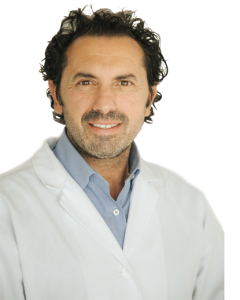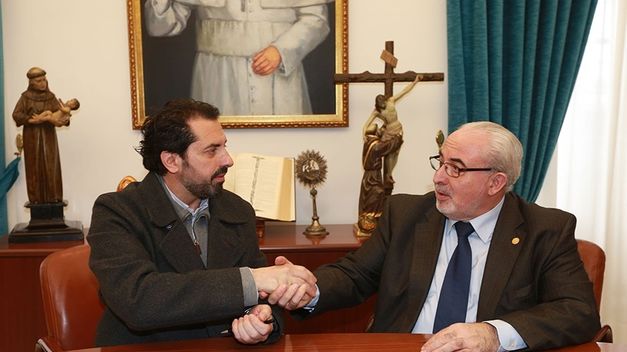© 2024 | Clinalgia Formación
Menu
Avenida Libertad 30009 / Murcia
Av. del Conocimiento 12. Edif. i+d Armilla. 18016 / Granada
Teléfono: +34 630 41 97 97

Dr. Hidalgo Tallón is one of the leading medical specialists in ozone therapy and chronic pain medicine in Spain and Europe.
He completed his medical and general surgery degree, as well as dentistry in Granada, specializing later in stomatology.
As a dentist, he received postgraduate training in endodontics, periodontics, prosthodontics, and implantology, always with a focus on enhancing differential diagnostic capacity in jaw, mouth, head, and neck pain.
As a algologist, he trained at the Institute of Neuroscience and Pain at the University of Granada.
He obtained his doctorate in medicine with a thesis on the therapeutic potential of antipsychotics in fibromyalgia.
He also completed an internship in the Orofacial Pain department at the University of Kentucky, directed by Dr. J.P. Okesson.
As a researcher, he is a member of the Headache, Psychotropics, and Fibromyalgia Research Group of the Andalusian Government and established the first European Chair of Ozone Therapy and Chronic Pain at the San Antonio Catholic University of Murcia.
In addition to delivering numerous lectures and serving as a visiting professor at various European and American universities, Dr. Hidalgo has multiple publications in journals such as Progress NeuropsychopharmacolBiol Psychiatry, Eur J Neurol, RheumatolInt, Pain Medicine, J Headache Pain, Pharmacopsychiatry, Head and face Medicine, Rev SocEsp del Dolor, ClinExpRheumatol, Eur Journal of Pain, Journal of Sex Medicine, Rheumatology, Clinical Rheumatology, among others.

Ozone is a gaseous molecule composed of three oxygen atoms (O3) instead of the two atoms (O2) that make up the oxygen molecule.
Ozone therapy involves the application of medical ozone at very low concentrations.
It must be produced “in situ” for each application since it cannot be stored due to its chemical instability.
This factor is one of the reasons for its limited diffusion, especially since the development of the pharmaceutical industry.
Medical ozone is synthesized on a base of medicinal oxygen, which is essential for its injected and insufflated use, and ozone should not be used from air concentrates as they contain oxides of other elements that would contraindicate its use in surgical fields.
Ozone has analgesic, anti-inflammatory, germicidal, and regenerative properties.
Additionally, it improves antioxidant systems and intracellular communications, thus regulating metabolism and protecting against cellular damage.
Does ozone therapy have globally recognized academic validation to support its results? Do you believe its implementation in healthcare systems is commensurate with its efficacy?
Medical recognition of ozonotherapy is increasing; in fact, it is a primary indication in pain medicine, and there are already more than twenty public hospitals using it.
Scientific evidence in this regard is extensive, especially in chronic lumbosciatic pain, where it outperforms treatments such as radiofrequency, surgery, or corticosteroids, according to a recent review by the Cochrane Collaboration.
It has been successfully used in almost all joints of the body, including the temporomandibular joint.
Once the biological, biochemical, and pharmacological effects of medical ozone are known, its potential in diseases related to alterations in cellular redox balance, immunity, ischemia, and infectious processes is extremely high.
It should be noted that much of the pharmacology and biochemistry of ozone is studied and published.
It is about biochemistry: medical ozone acts on cells like growth factors or drugs.
The oxidative stress model based in ozone inoculation is becoming a classic in cellular biology.
Which diseases are treated with ozone therapy?
In the clinical field, apart from pain medicine and diabetic foot, we have published works on diseases such as vascular dementia, Parkinson’s disease, retinitis pigmentosa, rheumatoid arthritis, hepatitis B and C, or cancer.
In the dental field, the main prospects of dental ozone therapy focus on periodontal processes and peri-implantitis.
Specifically in periodontal disease, my colleague Dr. Arturo Sánchez, Dr. Campos Aranda, and I demonstrated the safety and effectiveness of ozone.

This Chair is a young and cutting-edge initiative, the first of its kind in Europe.
We offer postgraduate training. We also have conducted several Ozone Therapy Courses in Pain Medicine to train healthcare professionals as specialists in ozone therapy.
We also have a Chair and a project with the Grünenthal Foundation, a reference institution specialized in pain medicine. We are conducting seminars on the etiopathogenesis and treatment of chronic pain oriented to primary care professionals.
In the stomatognathic field, it would be beneficial to implement training for dentists, as they are key in the diagnosis of craniofacial pain and the treatment of chronic headaches.
From this Chair, there is maximum interest in this regard since our education as pain specialists stems from stomatology.
Yes. We are developing animal models of ozone therapy as an adjunct treatment for chemotherapy in cancer, together with the University of Granada. It is very interesting that ozone helps patients tolerate chemotherapy better and thus benefit more from it.
Additionally, with ozone therapy, we have managed to slow down the growth of lung carcinoma and improve the immune system of mice.
In the field of pain, we have just read a thesis on the prevalence and impact of pelvic floor dysfunction in fibromyalgia.
We have also measured the effect of a nutraceutical based on marine RNA extracts in this same disease.
In the future, we have three clinical trials planned for the next academic year; one on systemic ozone therapy in fibromyalgia and two others on cancer, one of them exclusively on oral cancer.
We still have the study of ozone therapy in peri-implantitis on the agenda, as it was performed with great success in periodontitis.
In dentistry, ozone therapy has several applications, both topical (based on ozonized oils and ozonized water) and based on gas infiltrations and insufflations.
The scientific evidence is increasing, with studies in periodontal diseases, endodontics, dental operatory, surgery, cosmetic dentistry, and cranio-mandibular pain.
These are different indications and modes of application that we can continue to develop from here.
An expert medical ozone team with the relevant approvals is required.
Other than that, the applications are simple, as they do not involve any change in the daily treatment habits of our patients.
Recently, a course was held at the College of Dentists of Murcia, sponsored by SEDECAL, the Spanish Society of Ozone Therapy (SEOT), and UCAM.
Additionally, annually, SEOT organizes theoretical-practical courses on dental ozone therapy, endorsed by the University of Valencia.
A course is expected soon in GEMO, and it may possibly be repeated in Alicante.
From SEOT and the Chair in Ozone Therapy, the aim is to promote the benefits of medical ozone in stomatology, and to learn about its applications and how they should be carried out.
Finally, from our own training platform, we have developed an online ozone therapy course in dentistry that is highly practical, incorporating the latest scientific evidence to facilitate access to this specialized training in ozone therapy.
Contact us without obligation..
Murcia. Tlf. 968 28 16 25
Granada. Tlf. 958 870 200.
Avenida Libertad 30009 / Murcia
Av. del Conocimiento 12. Edif. i+d Armilla. 18016 / Granada
Teléfono: +34 630 41 97 97
Avenida Libertad 30009 / Murcia
Av. del Conocimiento 12. Edif. i+d Armilla. 18016 / Granada
Teléfono: +34 630 41 97 97
¿En qué podemos ayudarle?
También puede escribirnos a clinalgiaformacion@gmail.com o llamarnos al 968281625